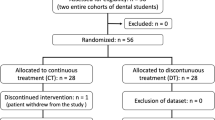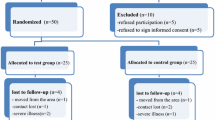Abstract
Purpose
To explore the impact of oral hygiene practices, as well as beliefs and attitudes toward orthodontic treatment on white spot lesion (WSL) development and plaque accumulation in orthodontic patients.
Materials and methods
A total of 106 individuals (61 female, 45 male) patients aged 10–49 years who were treated with fixed appliances treatment completed a 14-question survey regarding aspects of their oral hygiene (OH) and orthodontic visits. The number of teeth with WSL and the plaque indexes were recorded for each patient. Poisson regression and linear regression models were used to analyze the association of survey responses with the observed WSLs and plaque accumulation, respectively.
Results
Participants of both sexes reported similar beliefs about OH (66% agreed to the importance of OH statements), practiced proper OH (69% good practices), and reported a similar perception regarding the quality of their OH routine and of their orthodontic treatment. However, in total, none of the findings was significantly related to the development of WSLs or plaque accumulation. Significantly fewer WSLs were observed in male patients who perceived themselves as having good control over OH. Female participants reported significantly higher expectations regarding posttreatment smile improvement compared to males. Overall, responses by male participants were deemed to be more accurate than those by female participants when related to WSL development and plaque accumulation.
Conclusion
Our survey hints at a possible relationship between WSL formation and patients’ sense of control over OH routine in males. Future studies should further explore the effect of sex on the attitude toward and perception of OH in orthodontic patients. This survey highlights the multifactorial nature of WSL development in orthodontic patients and the complexity of predicting patient compliance.
Zusammenfassung
Fragestellung
Untersuchung des Einflusses von Mundhygieneverhalten sowie von Überzeugungen und Einstellungen zur kieferorthopädischen Behandlung auf die Entwicklung von White-Spot-Läsionen (WSL) und Plaqueakkumulation bei Kieferorthopädiepatienten.
Materialien und Methoden
Insgesamt 106 Patienten (61 weiblich, 45 männlich) im Alter von 10–49 Jahren, die mit festsitzenden Apparaturen behandelt wurden, beantworteten eine Befragung mit 14 Fragen zu Aspekten ihrer Mundhygiene (OH) und kieferorthopädischen Vorstellungen. Für jeden Patienten wurden die Anzahl der Zähne mit WSL und die Plaqueindizes erfasst. Anhand von Poisson-Regressions- und linearen Regressionsmodellen wurde der Zusammenhang zwischen den Umfrageantworten und den beobachteten WSL bzw. der Plaqueakkumulation analysiert.
Ergebnisse
Teilnehmer beider Geschlechter berichteten über ähnliche Überzeugungen in Bezug auf OH (66 % stimmten den Aussagen über die Wichtigkeit von OH zu), praktizierten ordnungsgemäße OH (69 % gute Praktiken) und gaben eine ähnliche Wahrnehmung hinsichtlich der Qualität ihrer OH-Routine und ihrer kieferorthopädischen Behandlung an. Insgesamt stand jedoch keiner der Befunde in signifikantem Zusammenhang mit der Entwicklung von WSLs oder Plaqueakkumulation. Signifikant weniger WSLs wurden bei männlichen Patienten beobachtet, die sich selbst so einschätzten, dass sie gute Kontrolle über die OH-Routine haben. Weibliche Teilnehmer berichteten über signifikant höhere Erwartungen hinsichtlich einer Verbesserung des Lächelns nach der Behandlung als männliche. Insgesamt wurden die Antworten der männlichen Teilnehmer in Bezug auf die Entwicklung von WSLs und die Ansammlung von Plaque als genauer eingestuft als die der weiblichen Teilnehmer.
Schlussfolgerung
Unsere Erhebung deutet auf einen möglichen Zusammenhang bei Männern zwischen der Bildung von WSL und dem Gefühl der Patienten, die OH-Routine zu kontrollieren, hin. Zukünftige Studien sollten den Einfluss des Geschlechts auf die Einstellung zu und Wahrnehmung von OH bei Kieferorthopädiepatienten weiter untersuchen. Diese Erhebung verdeutlicht den multifaktoriellen Charakter der WSL-Entwicklung bei Kieferorthopädiepatienten und die Komplexität der Vorhersage der Patientencompliance.

Similar content being viewed by others
Abbreviations
- IOPs:
-
Intraoral photos
- OH:
-
Oral hygiene
- PI:
-
Plaque Index
- VAS:
-
Visual analog scale
- WSL:
-
White spot lesion
References
Chapman JA et al (2010) Risk factors for incidence and severity of white spot lesions during treatment with fixed orthodontic appliances. Am J Orthod Dentofacial Orthop 138(2):188–194
Gorelick L, Geiger AM, Gwinnett AJ (1982) Incidence of white spot formation after bonding and banding. Am J Orthod 81(2):93–98
Ogaard B (1989) Prevalence of white spot lesions in 19-year-olds: a study on untreated and orthodontically treated persons 5 years after treatment. Am J Orthod Dentofacial Orthop 96(5):423–427
Tanner ACR et al (2012) White-spot lesions and gingivitis microbiotas in orthodontic patients. J Dent Res 91(9):853–858
Khalaf K (2014) Factors affecting the formation, severity and location of white spot lesions during orthodontic treatment with fixed appliances. J Oral Maxillofac Res 5(1):e4
Julien KC, Buschang PH, Campbell PM (2013) Prevalence of white spot lesion formation during orthodontic treatment. Angle Orthod 83(4):641–647
Dawes C (1996) Factors influencing salivary flow rate and composition. Saliva Oral Health 2:27
Featherstone JD (2004) The continuum of dental caries—evidence for a dynamic disease process. J Dent Res 83:C39–42
Dawes C (1970) Effects of diet on salivary secretion and composition. J Dent Res 49(6):1263–1273
Maxfield BJ et al (2012) Development of white spot lesions during orthodontic treatment: perceptions of patients, parents, orthodontists, and general dentists. Am J Orthod Dentofacial Orthop 141(3):337–344
Sampson V, Sampson A (2020) Diagnosis and treatment options for anterior white spot lesions. Br Dent J 229(6):348–352
Paula ABP et al (2017) Therapies for white spot lesions—a systematic review. J Evid Based Dent Pract 17(1):23–38
Hu HM et al (2020) Effectiveness of remineralizing agents in the prevention and reversal of orthodontically induced white spot lesions: a systematic review and network meta-analysis. Clin Oral Invest 24(12):4153–4167
Bishara SE, Ostby AW (2008) White spot lesions: formation, prevention, and treatment. Semin Orthod 14(3):174–182
Mei L et al (2017) Factors affecting dental biofilm in patients wearing fixed orthodontic appliances. Prog Orthod 18:4
Larsson BW, Bergstrom K (2005) Adolescents’ perception of the quality of orthodontic treatment. Scand J Caring Sci 19(2):95–101
Bos H, Prahl-Andersen B (2003) On the use of personality characteristics in predicting compliance in orthodontic practice. Am J Orthod Dentofacial Orthop 123(5):568–570
Scambler S, Delgado M, Asimakopoulou K (2016) Defining patient-centred care in dentistry? A systematic review of the dental literature. Br Dent J 221(8):477–484
Richter DD et al (1998) Effect of behavior modification on patient compliance in orthodontics. Angle Orthod 68(2):123–132
Joseph GP et al (2021) Mindset correlates with health-related quality of life assessment in patients with adolescent idiopathic scoliosis. Spine Deform 9(2):349–354
NICE (2016) Surveillance report 2016—Patient experience in adult NHS services: improving the experience of care for people using adult NHS services (2012) NICE guideline CG138
Scheerman JF et al (2016) Psychosocial correlates of oral hygiene behaviour in people aged 9 to 19—a systematic review with meta-analysis. Community Dent Oral Epidemiol 44(4):331–341
Daniels AS, Seacat JD, Inglehart MR (2009) Orthodontic treatment motivation and cooperation: a cross-sectional analysis of adolescent patients’ and parents’ responses. Am J Orthod Dentofacial Orthop 136(6):780–787
Nanda RS, Kierl MJ (1992) Prediction of cooperation in orthodontic treatment. Am J Orthod Dentofacial Orthop 102(1):15–21
Sergl H, Zentner A (2000) Predicting patient compliance in orthodontic treatment. Semin Orthod 6(4):231–236
Klages U et al (2005) Dental esthetics, orthodontic treatment, and oral-health attitudes in young adults. Am J Orthod Dentofacial Orthop 128(4):442–449
Al-Jewair TS, Suri S, Tompson BD (2011) Predictors of adolescent compliance with oral hygiene instructions during two-arch multibracket fixed orthodontic treatment. Angle Orthod 81(3):525–531
Bos A, Hoogstraten J, Prahl-Andersen B (2005) The theory of reasoned action and patient compliance during orthodontic treatment. Community Dent Oral Epidemiol 33(6):419–426
Stevens K (2016) Evaluation of plaque removal efficacy of a novel dye—containing toothpaste: a clinical trial. Int J Dent Oral Sci 3:185–189
Harris PA et al (2009) Research electronic data capture (REDCap)—a metadata-driven methodology and workflow process for providing translational research informatics support. J Biomed Inform 42(2):377–381
McCormack HM, Horne DJ, Sheather S (1988) Clinical applications of visual analogue scales: a critical review. Psychol Med 18(4):1007–1019
Delgado DA et al (2018) Validation of digital visual analog scale pain scoring with a traditional paper-based visual analog scale in adults. J Am Acad Orthop Surg Glob Res Rev 2(3):e88
O’Reilly MM, Featherstone JD (1987) Demineralization and remineralization around orthodontic appliances: an in vivo study. Am J Orthod Dentofacial Orthop 92(1):33–40
Benson PE, Pender N, Higham SM (2003) Quantifying enamel demineralization from teeth with orthodontic brackets—a comparison of two methods. Part 1: repeatability and agreement. Eur J Orthod 25(2):149–158
Benson PE, Pender N, Higham SM (2003) Quantifying enamel demineralization from teeth with orthodontic brackets—a comparison of two methods. Part 2: validity. Eur J Orthod 25(2):159–165
Savage MW et al (2015) Perceptions of oral health in Appalachian Kentucky: implications for message design. Health Commun 30(2):186–195
Poutanen R et al (2007) Oral health-related knowledge, attitudes, behavior, and family characteristics among Finnish schoolchildren with and without active initial caries lesions. Acta Odontol Scand 65(2):87–96
Hadler-Olsen S et al (2012) The incidence of caries and white spot lesions in orthodontically treated adolescents with a comprehensive caries prophylactic regimen—a prospective study. Eur J Orthod 34(5):633–639
Wedrychowska-Szulc B, Syrynska M (2010) Patient and parent motivation for orthodontic treatment—a questionnaire study. Eur J Orthod 32(4):447–452
Ajzen I (1991) The theory of planned behavior. Organ Behav Hum Decis Process 50:179–211
Kneckt MC, Syrjala AMH, Knuuttila MLE (1999) Locus of control beliefs predicting oral and diabetes health behavior and health status. Acta Odontol Scand 57(3):127–131
Beyer S, Bowden E (1997) Gender differences in self-perceptions: convergent evidence from three measures of accuracy and bias. Pers Soc Psychol Bull 23(2):157–172
Weisberg YJ, Deyoung CG, Hirsh JB (2011) Gender differences in personality across the ten aspects of the big five. Front Psychol 2:178
Shearman E et al (2011) A comparison of optimism levels and life stress levels among NCAA division I athletes and non athletes. J Issues Intercoll Athl 4:190–206
Fox RN et al (1982) Development and validation of a measure of attitudes toward malocclusion. J Dent Res 61(9):1039–1043
Sinha PK, Nanda RS, McNeil DW (1996) Perceived orthodontist behaviors that predict patient satisfaction, orthodontist-patient relationship, and patient adherence in orthodontic treatment. Am J Orthod Dentofacial Orthop 110(4):370–377
Nielsen MW et al (2021) Gender-related variables for health research. Biol Sex Differ 12:23
Funding
This research was partially supported by the following: Initial Manuscript Award (IMA) Grant, University of Kentucky, ORI_IRB #47148.
Author information
Authors and Affiliations
Contributions
L. Sharab: Conceptualization, Methodology, Validation, Investigation, Writing—original draft, Writing, Review & editing, Supervision, Project administration, Data curation; C. Loss: Investigation (data collection); A. Kluemper: Writing—original draft, Investigation (assist in data analysis); H. Nagaoka: Funding acquisition, Investigation; G. Hawk: Investigation (Statistical analysis); C. Beeman: Conceptualization, Supervision
Corresponding author
Ethics declarations
Conflict of interest
L. Sharab, C. Loss, A. Kluemper, H. Nagaoka, G. Hawk and C. Beeman declare that they have no competing interests.
Ethical standards
Patient enrollment was initiated after the institutional review board (IRB) approval of the institution (University of Kentucky). All patients/parents were consented before participating.
Additional information
Publisher’s Note
Springer Nature remains neutral with regard to jurisdictional claims in published maps and institutional affiliations.
Availability of Data and Material
The datasets used and/or analyzed during the current study are available from the corresponding author on reasonable request.
Supplementary Information
Rights and permissions
About this article
Cite this article
Sharab, L., Loss, C., Kluemper, A. et al. Effect of patients’ attitude and perception of oral hygiene on white spot lesion development and plaque accumulation during orthodontic treatment. J Orofac Orthop (2023). https://doi.org/10.1007/s00056-023-00463-5
Received:
Accepted:
Published:
DOI: https://doi.org/10.1007/s00056-023-00463-5
Keywords
- Sense of control
- Fixed orthodontic appliances
- Dental caries
- Patient compliance
- Surveys and questionnaires




